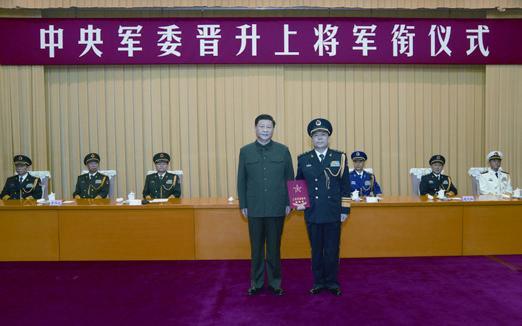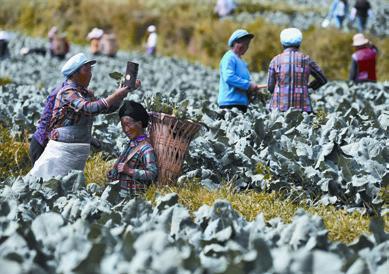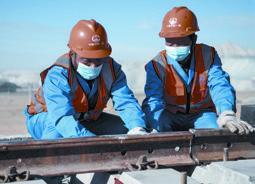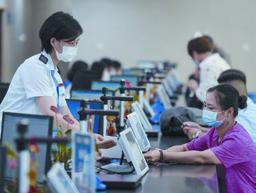A MOMENT OF GLORY

President Xi Jinping, also Chairman of the Central Military Commission (CMC), presents a certifi cate of order at a ceremony to promote Xu Zhongbo, Political Commissar of the Rocket Force of the Chinese Peoples Liberation Army, to the rank of general, on July 29.
The ceremony was held by the CMC in Beijing. General is the highest rank for officers in active service in China.
Harvest Season
Women in Fengyang, a town in Jiangxi Province, east China, pick water chestnuts on July 29. July to October is the harvest season for water chestnuts.Hepatitis Record
More than 1,400 hepatitis B patients have been cured thanks to a project on chronic hepatitis B treatment launched two years ago.This makes the clinical project the most effective one in the world in terms of the number of patients cured, according to the Chinese Foundation for Hepatitis Prevention and Control (CFHPC).
Nearly 10,000 patients and 312 hospitals have participated in the project since it was launched in April 2018.
Primary liver cancer is the fourth most common malignant tumor and the second leading cause of tumor deaths in China. About 85 percent of liver cancer patients have hepatitis B, said Yang Xizhong, Executive Vice Chairman of CFHPC, on World Hepatitis Day, July 28.
Viral hepatitis remains the class B infectious disease with the most reported cases in China, according to the National Health Commission.
About 70 million people are estimated to be living with hepatitis B, and another 7.9 million with hepatitis C. About 330,000 die each year from cirrhosis of the liver and primary liver cancer caused by hepatitis B or C infections in China.
“China still lags far behind the hepatitis B prevention and treatment goals set by the World Health Organization (WHO),” Yang said. The WHO target is diagnosis of 90 percent of cases and treatment of 80 percent. But the numbers are 18 percent and 11 percent respectively in China.
CFHPC initiated a new project on July 25 to further study reducing the incidence of liver cancer.
Telecom Fraud
Police have cracked about 101,000 cases related to telecom and Internet fraud in the fi rst half of this year, and arrested 92,000 suspects, up 73.7 percent and 78.4 percent year on year, respectively, the Ministry of Public Security said on July 28.According to data released by the ministry, 16,000 fraud cases related to the novel coronavirus disease (COVID-19) epidemic were busted, and 7,506 were arrested.
Public security organs have strengthened technical countermeasures and intensifi ed funds interception against dubious practices. They intercepted 120 million fraudulent phone calls and blocked 210,000 fraudulent websites, thus averting economic losses of 66.6 billion yuan ($9.53 billion), according to Liu Zhongyi, an offi cial of the ministry.
The hotline prevented approximately 5.61 million people from being defrauded, Liu added.
Ruins Found
An important ancient site was discovered next to the Sanxingdui Ruins in the city of Guanghan, Sichuan Province in southwest China, Chinese archeologists announced on July 28.The new discovery is believed to be a 5,000-year-old settlement. The Sanxingdui Ruins are thought to be remnants of the Shu Kingdom which can be dated back 2,600 years to 4,800 years. In 1988, the ruins were given state-level protection.
A large number of potteries, porcelain and stoneware have been unearthed from the site, about 8 km south of the Sanxingdui Ruins.
“This is the fi rst time that a complete sequence of the ancient Shu civilization has been found around Sanxingdui,” said Xin Zhonghua, an associate researcher with the Sichuan Provincial Cultural Relics and Archeology Research Institute.
The majority of relics unearthed from the settlement ruins have the features of Sanxingdui culture, according to Xin.
“The site refl ects an uninterrupted regional development history of nearly 5,000 years, which is of great signifi cance to the study of the origin, development and evolution of the ancient Shu civilization,” he said.
Listed among Chinas top 10 archaeological fi ndings in the 20th century, the Sanxingdui Ruins were accidentally discovered by a farmer when he unearthed a bright piece of jade while digging a ditch in 1929.
Some gold masks with exaggerated designs are among the most impressive relics unearthed.
Two sacrif ciial pits f liled with more than 1,000 treasures, including gold masks, bronzeware, jade tablets, and ivory and sacred trees, were discovered in 1986 when workers were excavating clay for bricks.
Poverty Alleviation
The Ministry of Civil Affairs has issued a circular on providing fi nancial support to social organizations to carry out poverty alleviation projects.Local authorities are being encouraged to increase investment and introduce social capital for farmland construction with incentives.
The ministry also strengthened supervision on construction procedure while improving a nationwide monitoring system.
More work will be done to advance the construction and enhance project quality management to complete this years target on schedule.
The aim is to develop 67 million hectares of such farmland by 2022 with a grain output of 500 million tons, according to a circular by the General Offi ce of the State Council, Chinas cabinet.
Hi-Tech Resilience
Chinas national hi-tech zones have maintained growth despite the impact of the epidemic, a senior offi cial said on July 23.In May, the revenue of hi-tech zones reached 3.27 trillion yuan($467 billion), up 10.3 percent year on year, and the export volume reached 319 billion yuan ($45.5 billion), an increase of 13.7 percent year on year, Xu Nanping, Vice Minister of Science and Technology, said at a press conference.
With strong scientifi c and technological innovation capacity, the hi-tech zones have shown resilience to risks and registered higher growth than the national average, Xu said.
In the fi rst quarter of this year, the zones employed more than 26.56 million people, a rise of 2.1 percent year on year. A total of 508,000 new jobs were created in the zones during that period, up 6.7 percent year on year.
National hi-tech zones play a vital role in promoting innovation-driven development and establishing valuable experience for Chinas high-quality economic development, Xu added.
China unveiled a guideline on high-quality development of national hi-tech zones in July, stressing efforts in spurring innovation, deepening reform, and expanding opening up in this sector.
Xu said after more than 30 years development, national hi-tech zones have become an important support base for the economy.
In 2019, the 169 national hi-tech zones created 12.2 trillion yuan ($1.74 trillion) in output and paid 1.9 trillion yuan ($270.9 billion) in taxes and fees, accounting for 12.3 percent of the GDP and 11.8 percent of the tax revenue.
The zones have nurtured innovative companies with international infl uence, and developed a number of world-class industrial clusters in photovoltaic electricity, wind power and new-energy vehicles.

Rail Under Construction
Workers check the track at the site of the Golmud-Korla Railway in Xinjiang Uygur Autonomous Region in northwest China on July 18. The railway links Golmud in Qinghai Province, northwest China, and Korla in Xinjiang. The construction in Xinjiang is progressing in an orderly manner.Live-Stream Boom
Kuaishou, a leading short-video platform in China, reported a huge jump in the number of live-streaming users in the fi rst half of this year on July 22, mainly driven by the COVID-19 epidemic that prompted wider use of the service.The Beijing-based company, a major domestic rival of Douyin, said the number of daily active users of its live-streaming function reached 170 million as of June, a surge of 70 million since the end of 2019.
The explosive expansion came as the COVID-19 epidemic kept people across the nation indoor for months, while live-streaming services were increasingly adopted in sectors as diverse as entertainment, e-commerce, tourism and education.
By March, China had 560 million users of live-streaming services, a rise of 163 million from that in December 2018, the China Internet Network Information Center said in a report in April.
Online shopping has particularly benefi ted from live-streaming to become a strong support for epidemic-battered production and consumption. On Kuaishou alone, over 100 million users are engaged in e-commerce each day, and more than half of them are from the thirdand fourth-tier cities.
Among all the new e-businesses set up on Kuaishou in the fi rst half of the year, those in automobiles, smartphones, home supplies, beauty and cosmetics and education were more likely to take up livestreaming, the platform said.
Battery Swap Mode
China will step up efforts to advance the construction of battery swap infrastructure in the latest move to promote quality growth of the newenergy vehicle (NEV) sector, the Ministry of Industry and Information Technology (MIIT) said on July 23.The battery swap mode will be piloted in regions including Beijing and Hainan, Xin Guobin, Vice Minister of MIIT, told a press conference.
Leading the world in NEV output and sales in the past fi ve years, China has built 38,000 battery charging stations, 449 battery swap stations, and 1.3 million charging poles, MIIT data shows.
Despite its rapid expansion, the sector lacks strong core technologies and charging convenience, he said.
The battery swap mode, conducive to extending the life of batteries, will enhance safety and lower costs for buyers, according to Xin.
Enterprises are also encouraged to develop new battery charging and swapping technologies, according to MIIT.

